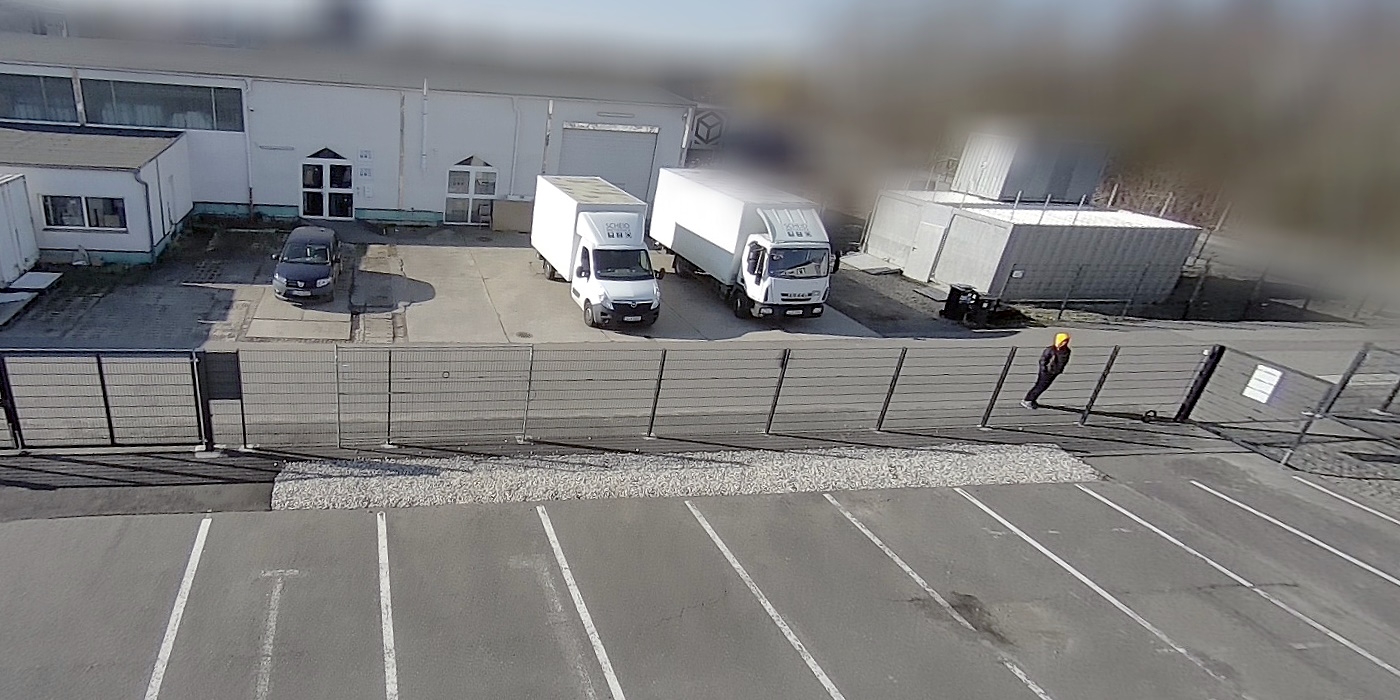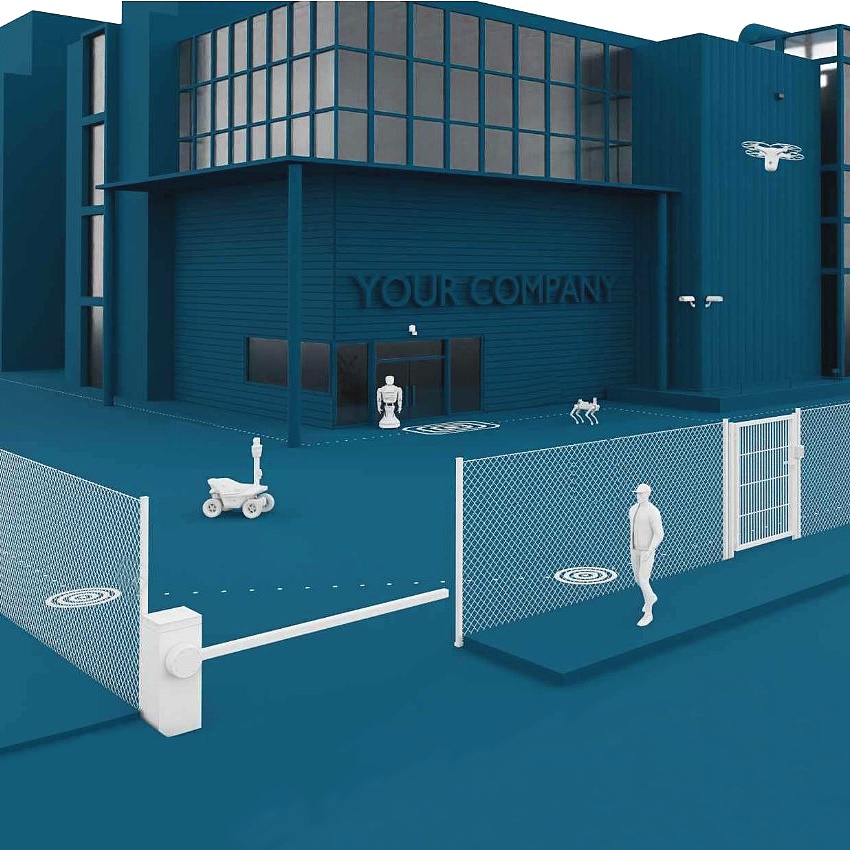
In current, more aptly called conservative security concepts, technical solutions are often still used too selectively, a camera here, a motion detector there, a light barrier there. Although attention is paid to covering critical and access areas as completely as possible, especially with cameras, the focus is rarely on the entire perimeter. Serious security incidents, such as those that occurred at several airports in 2022, show how quickly this can take revenge. What is missing is a holistic approach to the security concept and an understanding of how networked security technology, including surveillance robots, works. We clarify.
When we talk about modern security concepts, we always focus on our central platform solution. Acuda® connects and networks all actuators with each other and allows their bidirectional data exchange. In this way, not only potential alarms are transmitted, but also position, status, etc., depending on the system. Actuators are all security systems that are already IoT-capable or enabled via Nucron®, i.e. all existing fixed cameras, status detectors such as doors, barriers, motion detectors and also all security robots integrated in this system.
The operators therefore always know where which technology is performing its defined task in which state, whether, when and which potential alarms, faults, etc. occur, and thus receive a complete overview. Cleverly thought out, a maximum of security can be guaranteed 24/7, i.e. penetration attempts are detected in the beginning and in real time and corresponding automatic or manual reactions are triggered.
We at Security Robotics are developers and integrators, which is why we can integrate all types of sensor and camera technology – independent of the manufacturer – and also enable the connection to every type of NSL – emergency call and service control centre. Let us explain the facts and possibilities with a concrete example.

All safe, is it?
In a typical scenario, the fenced perimeter with various gates, individual buildings with doors and windows, as well as various storage and parking areas are usually to be protected. The main gate is secured by a barrier and a guard house, the fence is solid and possibly equipped with climbing protection. There are swivelling cameras at the outer corners of the buildings and a PTZ dome camera keeps an eye on the car park and parking areas. Mechanical locking systems and an alarm system are installed on doors and windows. Perhaps a security guard also makes his rounds on the property from time to time. So far, so typical.
But this supposedly adequate security solution, which has been schematically sold as the ideal form for many years, has glaring weaknesses, because all elements act independently of each other:
- Barrier and main gate on mechanical opening or the care of the guard.
- Fences and walls are purely mechanical, static obstacles whose condition can only be checked on a guard walk.
- The anti-theft system only as soon as windows or doors would be opened by force.
- The patroller has to rely on his eyes and ears and is connected to his colleagues by telephone at best, but never to the systems.
- And the cameras? With good onboard detection software, they report suspicious movements, but they are limited to their field of vision.
The decentralisation and especially the lack of digitalisation of security measures thus leaves gaps that criminal elements can easily exploit. If security robots were also added to this concept as a single element, i.e. if they were only assigned a task but were not networked, the positive effect would be limited.

How can property protection be made better + safer?
- In the first step, existing systems must be digitised, i.e. their messages, alarm signals and status must be summarised in a central place. In our example, this concerns doors and gates, whose status, i.e. closed, open, defective, etc., is now clearly visible instead of being personally inspected. This upgrade can be carried out by means of Nucron®.
- Fence systems are retrofitted with a detection cable and are no longer just a passive part of the perimeter protection. This system, such as Sorhea’s G-Fence 3000, incorporates vibration and acceleration sensors and thus registers any manipulation of the fence, whether climbing, cutting, pushing in or breaking through. Each individual fence field is sensorically a zone of its own, which enables a pinpoint assignment of potential penetration attempts.
- In the case of extensive objects, it is easy to add long-range motion detectors and intelligent cameras to the perimeter protection by setting up video towers such as the Watchdome systems from GT.AI or the mobile video surveillance from Dussmann.
- In the future, patrols will not be mapped by a person, but by security robots. Depending on the size of the area, these are on the move on 4 legs (also indoors) (ideal here Spot) or travel their programmed routes continuously (perfect for Argus). Thanks to a complete 360° view, operation independent of time of day and weather, and flexible equipment, robotic systems can do more in this area than even the most experienced security guard.
- All messages converge at a central point such as the guard building or the security centre. This means that the security expert not only has an eye on the small area of the access road, but is fully informed about the integrity of the property.
The decisive quality leap and thus increased security, cost-efficient and reduced false alarms, is achieved when all the measures mentioned work as an integrated system, together, complementing and supporting each other.
Security you can rely on
We at Security Robotics do not believe in full-bodied promises and pure showcases. That’s why we extensively test security robots, sensors of all kinds and, of course, the systems of companies on our own research premises, which we regard as the added value of a holistic security concept.
Only when everything meshes perfectly and functions as a networked whole do we stand behind it, offer it in customer projects and also integrate this technology into the Acuda® platform.
It is impressive how agile robotic systems react to penetration attempts without delay, unerringly targeting the section in question, such as a fence field or gate, while directing their sensors at the potential troublemaker. Argus can use its loud announcements as a deterrent, Spot can stream the incident in sound & vision, and the Beehive drone system can provide unparalleled clarity.
Above all, the flying robot is perfect for verifying/qualifying alarms and, in case of doubt, can be on site faster than any security guard. If the need arises, other systems are sent to the incident in support.
Security 2023: Not the same as always, but doing it better!
Single solutions have had their day. A simple more instead of better, a purely staff-centred approach and ignoring the need to use networked robotic and security systems is already no longer sufficient. In the future, security service providers will not be able to meet customer requirements and customers will virtually invite criminal elements thanks to the poor quality of their measures. It does not have to come to that.
A conclusion that should also be yours.
Talk to us.
CONTACT FOR PRESS & COMMUNICATION:
Michael Engel | m.engel@security-robotics.de
Landsberger Allee 366, 12681 Berlin
Telefon: +49 341 2569 3369